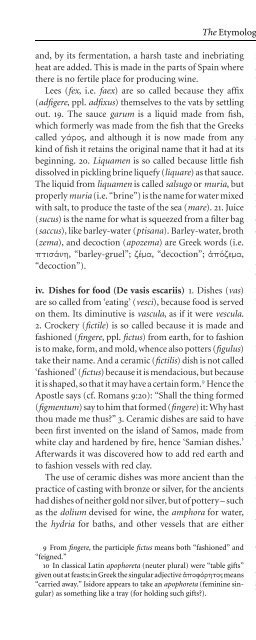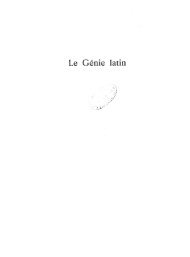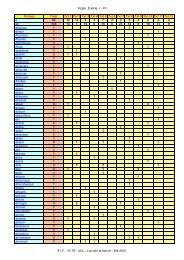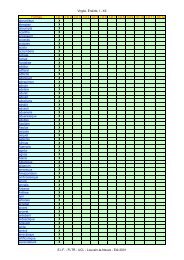The Etymologies of Isidore of Seville - Pot-pourri
The Etymologies of Isidore of Seville - Pot-pourri
The Etymologies of Isidore of Seville - Pot-pourri
Create successful ePaper yourself
Turn your PDF publications into a flip-book with our unique Google optimized e-Paper software.
and, by its fermentation, a harsh taste and inebriating<br />
heat are added. This is made in the parts <strong>of</strong> Spain where<br />
there is no fertile place for producing wine.<br />
Lees (fex, i.e. faex) are so called because they affix<br />
(adfigere, ppl. adfixus) themselves to the vats by settling<br />
out. 19. <strong>The</strong> sauce garum is a liquid made from fish,<br />
which formerly was made from the fish that the Greeks<br />
called , and although it is now made from any<br />
kind <strong>of</strong> fish it retains the original name that it had at its<br />
beginning. 20. Liquamen is so called because little fish<br />
dissolved in pickling brine liquefy (liquare)asthat sauce.<br />
<strong>The</strong> liquid from liquamen is called salsugo or muria,but<br />
properly muria (i.e. “brine”) is the name for water mixed<br />
with salt, to produce the taste <strong>of</strong> the sea (mare). 21.Juice<br />
(sucus)isthenameforwhat is squeezed from a filter bag<br />
(saccus), like barley-water (ptisana). Barley-water, broth<br />
(zema), and decoction (apozema) areGreekwords (i.e.<br />
, “barley-gruel”; , “decoction”; ,<br />
“decoction”).<br />
iv. Dishes for food (De vasis escariis) 1. Dishes (vas)<br />
are so called from ‘eating’ (vesci), because food is served<br />
on them. Its diminutive is vascula, asifitwerevescula.<br />
2. Crockery(fictile) issocalled because it is made and<br />
fashioned (fingere,ppl. fictus)from earth, for to fashion<br />
is to make, form, and mold, whence also potters (figulus)<br />
take their name. And a ceramic (fictilis)dishisnot called<br />
‘fashioned’ (fictus)because it is mendacious, but because<br />
it is shaped, so that it may have a certain form. 9 Hencethe<br />
Apostle says (cf. Romans 9:20): “Shall the thing formed<br />
(figmentum)say to him that formed (fingere)it: Why hast<br />
thou made me thus?” 3.Ceramic dishes are said to have<br />
been first invented on the island <strong>of</strong> Samos, made from<br />
white clay and hardened by fire, hence ‘Samian dishes.’<br />
Afterwards it was discovered how to add red earth and<br />
to fashion vessels with red clay.<br />
<strong>The</strong> use <strong>of</strong> ceramic dishes was more ancient than the<br />
practice <strong>of</strong> casting with bronze or silver, for the ancients<br />
had dishes <strong>of</strong> neither gold nor silver, but <strong>of</strong> pottery – such<br />
as the dolium devised for wine, the amphora for water,<br />
the hydria for baths, and other vessels that are either<br />
9 From fingere, the participle fictus means both “fashioned” and<br />
“feigned.”<br />
10 In classical Latin apophoreta (neuter plural) were “table gifts”<br />
givenout at feasts; in Greek the singular adjective means<br />
“carried away.” <strong>Isidore</strong> appears to take an apophoreta (feminine singular)<br />
as something like a tray (for holding such gifts?).<br />
<strong>The</strong> <strong>Etymologies</strong> XX.iii.19–iv.13 399<br />
made on the wheel or shaped by hand for human use.<br />
4. <strong>Pot</strong>ter’s clay (argilla) whenfiredisspoken<strong>of</strong>as‘pottery’<br />
(testa), because from being s<strong>of</strong>t it is ‘baked hard’<br />
(tosta), and it does not keep its original name, because<br />
it is not what it was. 5. Arretine (Arretinus) dishes are<br />
named for the Italian city Arretium (i.e. Arezzo), where<br />
they are made, and they are red. On these, Sedulius (Preface<br />
to the Paschal Poem 16):<br />
Vegetables which red pottery displays and serves.<br />
6. Some think that Samian dishes got their name from<br />
Samos, a town <strong>of</strong> Greece. Others say that there is a white<br />
potter’s earth from Italy, produced not far from Rome,<br />
that is called Samian. 7.Chased (caelatus)dishes are silver<br />
or gold, modeled inside and out with figures that stand<br />
out, so called from an engraver’s burin (caelum), which<br />
is a kind <strong>of</strong> iron tool, which commonly is called a chisel<br />
(cilio). 8. Chrysendetus vessels are those inlaid with gold;<br />
the term is Greek (cf. ,“gold”; “bind on”).<br />
Vessels in bas-relief (anaglypha)arethose carved on top,<br />
for the Greek means “above,” , “carving,”<br />
that is, carved above.<br />
9. Adish (discus) formerly was named scus after its<br />
resemblance to a shield (scutum); hence also ‘salver’<br />
(scutella). Afterwards it was called discus because it ‘gives<br />
food’ (dare escas), that is, it serves it – from this also<br />
is ‘those reclining at table’ (discumbentes) –orelseit is<br />
from the word (i.e. ,“throw”), that is, from<br />
the thing they throw (i.e. ,“discus”). 10.Tableware<br />
(messorium)issocalledfrom ‘table’ (mensa), as if it were<br />
mensorium. Aparapsis is a four-sided dish with ‘compartments<br />
<strong>of</strong> equal size’ (par apsis). A paten (patena),<br />
because it has a spreading, open (patere,present participle<br />
patens) rim.11. Platter (lancis, i.e. lanx) ...Gavata<br />
(i.e. gabata, akind <strong>of</strong> dish), because it is ‘hollowed out’<br />
(cavare,ppl. cavatus), with g put for the letter c.Likewise<br />
also mussel-shell (conca, i.e. concha), but the former is<br />
‘hollowedout’(cavatus), the latter is hollow (concavus):<br />
the Greeks also make this distinction. A salver (scutella)<br />
is the diminutive <strong>of</strong> shield (scutum), because it resembles<br />
one. 12. Anapophoreta is so named by the Greeks<br />
(i.e. ) from‘carrying fruits’ (ferre pomum)<br />
or anything [else], for it is flat. 10<br />
A salt-cellar (salinum) isavessel used for salt (sal).<br />
A sulzica is the same thing, as if it were salzica. Avinegar<br />
cruet (acitabulum), as if the word were acetaforum,<br />
because it ‘carries vinegar’ (acetum ferre). 13. Spoons

















